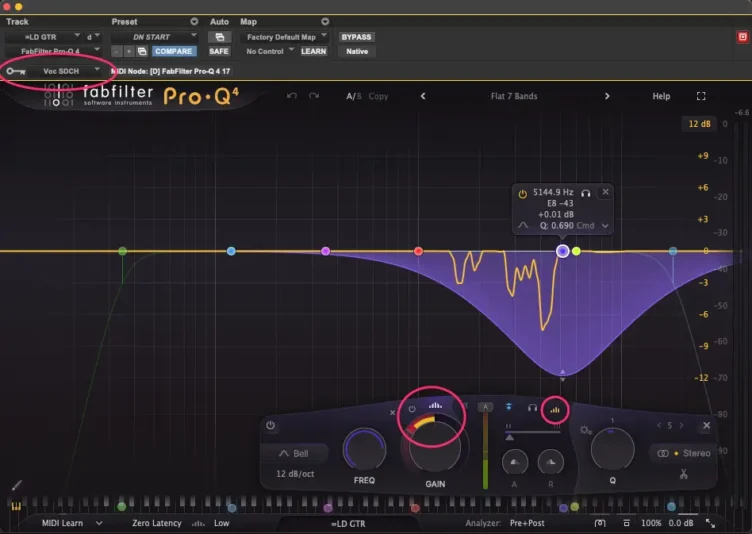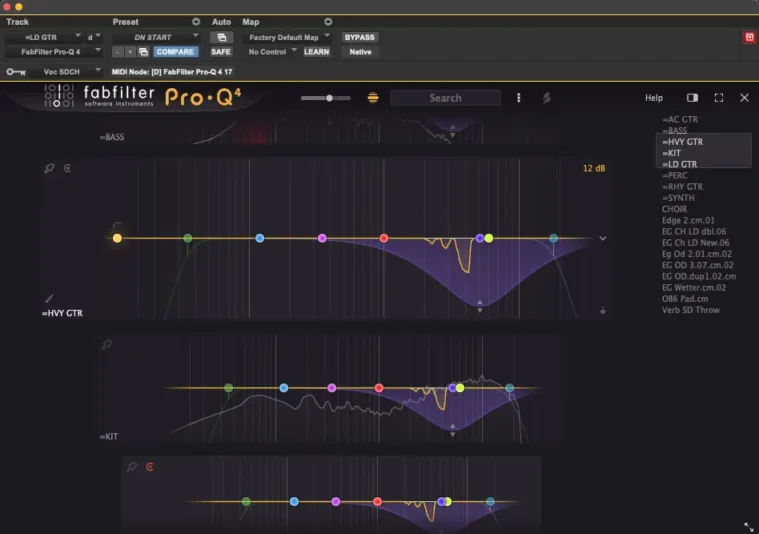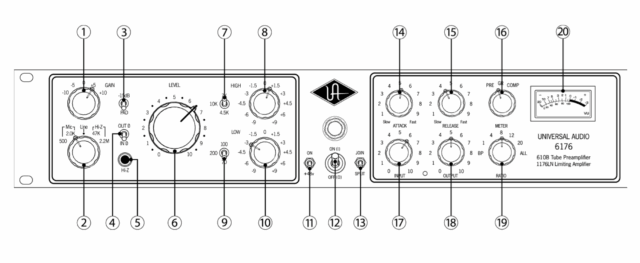Forum Replies Created
-
Jezzeeee! I’m so pumped to listen to this, and thanks for your patience 💜 – and thanks @-PT for chiming in here w/ the gems! It’s been an epic multi-artist, multi-session, long-hours week for me and I’m just coming back to life over here, lol. Gonna give this new track of yours a spin as soon as I’m back from a “walking donut tour of Santa Monica” … yes, you read that right 😂 🍩 🎡
-
Dana Nielsen
Administratorat 4:20 pm in reply to: 2 tracks – house of love and born + raised – meeting industry standard?Thanks for uploading those files, @nategomoon, and for your sonic reference (sound coming from a person playing in a room, some distance away from the listener, plus Fleet Foxes vibes) – super helpful context and totally doable with your source tracks.
You might try bussing your vocal AND piano into a stereo aux “ROOM” track and apply a room simulating plugin on that aux. Then, for a realistic “in the room with the player” vibe, you could keep the room plugin at 100% wet and simply adjust the plugin controls related to distance and size, bringing the listener closer or farther away from the performance… within the reverb interface.
For the Fleet Foxes reverb, I would add that as an aux send from the individual vocal/piano tracks, returning on its own aux return. That way you’ll be sending dry voc/pno to the Fleet Foxes verb and not a roomy-sounding source (tho you could experiment with that too!).
-
IT’S FINALLY OUT!! ⚡️
Wrote the music and lyrics and recorded/produced/mixed this whole thing in a day. The ad agency picked it from lots of submissions and had no notes, lol, which NEVER happens!
Thanks, amazing MP fam, for all your support and pozzy vibes – you surely tipped the cosmic needle toward bringing this gig home! 💜
-
Hey @barrose! Love this question, and thanks for the thoughtful context!
You’re comparing a few solid options: your current UAD 6176 (which I also own and recommend often), your Apollo Solo, and the Neve 88M you’re considering. I know the 6176 is on loan or going away, so the core of your question is: Is the 88M a step forward or a step back?
Here’s my honest take…
TL;DR: Preamp ≠ Magic … EQ + Output Control = Magic
The Neve 88M is no doubt a high-quality piece of gear. But so is your Apollo Solo, and honestly, when it comes to just mic preamps, the differences between most units – even boutique ones – are often overstated, especially in a clean, low-gain scenario like vocals or acoustic guitar. Both the Solo and 88M offer clean, low-noise gain with solid conversion.
But what I personally really care about in a preamp isn’t the name on the front, it’s:
-
A bit of EQ (even just a top-end shelf or low cut)
-
An output fader (so I can push the input gain and back off the output for harmonic saturation)
That’s why I love the 6176. With input and output controls, you can drive the tube preamp for tone and still maintain proper recording levels … something neither the 88M nor Apollo Solo really let you do.
If your 6176 is going away and you want to replace both your interface and preamp in one move, then sure, the 88M can work, but it’s not likely to sound radically better than your Apollo Solo. Without EQ or output trim, it’s just… gain.
And when you’re not pushing gain into breakup or leaning into transformer coloration, most preamps (yes, even Neve) are going to sound more alike than different.
My Real-World Suggestion:
If it were me, I’d either:
-
Keep using your Apollo Solo and take full advantage of the UAD Console to add EQ/compression on the way in (just like you’d print with a 6176), OR
-
Invest in a more full-featured channel strip, something with EQ and output control that lets you shape your sound before hitting the DAW
$1,200 is a lot to spend on another “clean” preamp when you already have one in the Apollo. That money might go further toward a versatile mic, plugin suite, or even a 6176 of your own!
🎛️🎚️
Ultimately, the Neve 88M is well-built, but I wouldn’t expect it to be some massive sonic upgrade over what you already have unless you’re specifically craving that Neve badge or want to simplify your rig with an all-in-one interface.
Hope that helps! And would love to hear what others think, especially if anyone’s using the 88M and has A/B’d it with UA gear!
⚡️ Dana
-
-
Hey Bar! (and @sexton)! Wow, I love this – such beautiful playing and recording! And to @-PT‘s point, I agree — @JLew will totally dig this awesome instrumental 😊.
“Outlaw” lolol – perfect word for that wonderful feeling of “breaking the rules” with your equipment. Haha, love it! Whatever you’re doing to “abuse” that 6176 sounds GREAT – keep it up!
I’m not familiar with those other specific pieces of gear you mentioned but in general, heck yeah, these days it’s easier and easier to get expensive-sounding results using budget-friendly gear. You could probably even return/exchange for something different if you’re not satisfied with your first choice (assuming you’re buying something new from Guitar Center, Sweetwater, Amazon, etc.).
No matter the brand/model you settle on, per the video above in this thread, I would just try to find a piece (or pieces) of gear that ‘check the same boxes’ as that 6176 if you can:
- Input gain AND output fader/knob (to control digital peaks when you’re in “Outlaw Mode” 🤠)
- EQ for tone shaping on the way into your DAW
- Compressor/limiter option for shaping dynamics on the way in, and controlling peaks/overs in your DAW
Let us know what you decide on, Bar!
I’m gonna listen to that instrumental again now, cause it’s so nice! 🙌
-
Dana Nielsen
Administratorat 9:23 am in reply to: 2 tracks – house of love and born + raised – meeting industry standard?My pleasure, man! Altiverb is amazing for lots of actual sampled living rooms and real spaces (and has tons of real halls and stadiums too). Waves IR reverb has this too but a less intuitive graphic interface. Logic may have its own Impulse Response reverb as well – not sure. But i find for realistic sounding rooms IR verbs are the way to go. I use UAD Ocean Way plugin a lot for this too but it definitely sounds more like a professional recording studio than a room in a regular house. Have fun!
-
Hahaha u know it! 👴
Thanks brother!
PS – when we gonna get some new J-Beat jams?! 🙏💜
-
😂 You know I’m here for ALL the duckees! 🦆🦆🦆
-
The ducking you hear in the ad was applied by the broadcast mix team in their final rerecord mix session, and yeah – full bandwidth for sure! Haha. I feel like that’s the commercial and radio style that everyone’s used to hearing. And like you said, it really makes the VO the star of the show / lead singer, which is exactly what they want.
But heck yeah, I love using a lead vocal to key frequency-specific compression on drums/gtrs/etc! Lately I’ve been doing that with Fabfilter Pro-Q 4’s built-in dynamics set to Spectral Mode across my submasters. Works incredibly well!
For ads and VO, another great trick – even better than keying and ducking – is producing the arrangement itself to stay out of the vocal range during VO sections, or even composing music with VO in mind. Think: sparse arrangements using low- or mid-frequency instruments, etc. That way, less ducking is required, and ad agency folks are drawn to your track as they test it internally against their ever-changing VO – cause, let’s face it, those folks in the boardroom ain’t duckin’ sh&#! 😂
-
I actually was provided with a temp voiceover placed exactly where they wanted it and was able to compose and arrange the song so as not to interfere w the VO.
I also do my own VO ducking on my mixes when submitting things so that it sounds more finished when they’re evaluating submissions.
When submitting, I send 2 files: a :30 sec .mov file w music, VO, picture all baked together, as well as a .wav with only the music- at mastered volume like a “found” track on Spotify they were interested in licensing. The .wav music-only fike runs longer, about :45 sec so they have additional material to edit with.
-
Haha – thanks, Sharon! (and sorry for the delayed response!)
-
Yay! Glad u got some good tips from it, @barrose!
A) You can actually drive the preamp input (1) and turn down the output (6) of the preamp independent of the compressor. You can, for example, bypass the compressor and use the Preamp Out (XLR on back of the unit) straight to the line input of your Apollo.
B) yep!- you can also link the Preamp Out to the Compressor In using the front-panel Join switch (13). 1-3db of reduction at 4:1 would be a safe conservative setting for natural sound. But don’t miss the more exciting/hype-y sounds you can get with that 1176-style compressor! The setting I use for almost everything on any 1176 is Slowest Attack, Fastest Release, 4:1. Push the compressor input until it sounds too compressed, then dial back the input to taste, always adjusting the compressor output as needed to avoid digital overs in your DAW.
Oh, and here’s a link to the manual – Page 3 has a great description and overview!
-
Dana Nielsen
Administratorat 10:22 pm in reply to: 2 tracks – house of love and born + raised – meeting industry standard?Oh interesting re vocal sound! Is it the same mic and input chain you used for Born and Raised? If so, my next question is: are you applying the reverb as an insert or a send?
If your reverb plugin is inserted directly on the vocal track, that might be causing the sound I’m hearing… 🤷🏻♂️
Try using an aux send on the vocal track to send a bit of it to an aux return. Insert your reverb on the aux return and set the mix/blend knob to 100% wet. That way you’ll hear your dry vocal, unadulterated, plus the reverb added to it by way of the send/return path.
-
Dana Nielsen
Administratorat 1:51 pm in reply to: 2 tracks – house of love and born + raised – meeting industry standard?Soooo much better, Nate! Great work on both of these – they’ve really come a long way!!
My tiny thought on Born and Raised is perhaps the cello has a touch too much airy top-end on it, especially noticed in the cello intro. You could try dialing back whatever top eq you have on the cello and see if it warms up a touch. Or not! Sounds good as-is too 🙂
2 things on House of Love:
- I heard a tiny little edit or automation bump at 2:12 on the piano
- There’s still a bit of that comb-filtered vocal sound- usually due to vocal bleed in the piano mics needing a bit of time alignment with the vocal mic.
Were the vocal and piano performed simultaneously? If so, you could try plugins like SoundRadix Auto-Align or UAD Little Labs IBP; or you could zoom in and look at the waveforms, find a vocal entrance or accent that’s visible in both the vocal mic and piano mics waveforms, then nudge the vocal mic audio files later to match the piano vocal bleed (you could also leave the vocal audio files where they are on the timeline and delay their output by inserting a simple delay plugin on the vocal channel to compensate for the difference. Just make sure your delay is set to milliseconds, and choose one that doesn’t color the sound.)
If you’re lost or unsure what I’m blathering on about, lol, you’re welcome to send me a link to your dry piano and vocal multitrack files and perhaps I can do a quick video demonstration 🙂
Again though.. amazing work, @nategomoon! Huge progress! Keep it up!





Social Media